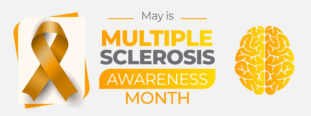New infusion drug in development
Two late-stage studies have found that a new infusion drug appears to be highly effective for multiple sclerosis (MS). The drug, alemtuzumab (brand name Lemtrada), is a monoclonal antibody that targets a specific protein (CD52) on the surface of immune cells (T cells) to destroy them.
Alemtuzumab is dosed as an infusion (a slow drip into a vein) once a day for five days. The drug is then re-dosed for three days in a row a year later. So the actual number of days taking the medication is only 3-5 days per year.
Two phase III studies have now examined the drug. In the CARE MS-I study, 563 people with early relapsing-remitting MS received either first-line alemtuzumab or Rebif (interferon beta-1a) for two years (Cohen and colleagues. Lancet 2012;380:1819-1828). During that period 22% of people in the alemtuzumab group had a relapse compared to 40% in the interferon group. The annualized relapse rate (ARR; average number of relapses per person per year) was 0.18 with alemtuzumab and 0.39 with the interferon (i.e. 55% lower with alemtuzumab). An ARR of 0.18 translates to about 1 relapse every 5 years, or 1 in 5 people having a relapse per year. The proportion of people with no relapses during the two-year study was 77.6% with alemtuzumab and 58.7% with the interferon. A total of 39% of people treated with alemtuzumab and 27% of those on the interferon had no evidence of disease activity (no relapses, no disability progression and no new lesions on their MRI). The impact on disability progression was similar with the two drugs.
In contrast to the CARE MS-I study, people in the CARE MS-II trial had received prior treatment with an interferon, Copaxone or Tysabri and had continued to have relapses. The study compared alemtuzumab and Rebif in 798 people with MS. In this group of people the results were a little less robust: the ARR was 0.26 with alemtuzumab and 0.52 with the interferon (50% lower with alemtuzumab). People taking alemtuzumab showed a slight improvement in disability compared to a small worsening of disability on the interferon. About one-third of people had no signs of MS activity with alemtuzumab compared to 14% in the interferon group.
One concern with alemtuzumab is potential safety issues. The phase II CAMMS223 trial was stopped early after three people developed severe autoimmunity (one person died) (CAMMS223 Investigators. N Engl J Med 2008;359:1786-1801). About 1 in 4 developed thyroid problems.
In the two phase III studies, treatment appeared to be generally tolerable and few people dropped out the trials because of adverse effects. People were closely monitored for signs of autoimmunity. The most common side effects with alemtuzumab were a result of the infusion; these included headache (43% of people), rash (about 40%) and fever (16-33%). Interferon side effects included flu-like symptoms and headache. Thyroid problems affected 15-18% of people; this included three cases of thyroid cancer, although it isn’t clear if they were related to the drug. Most people (66-77%) developed some kind of infection during alemtuzumab. About 1 in 7 people developed a herpesvirus infection (such as cold sores or shingles), although most took antiviral medications during the study as a preventative.
Share this article
Facebook Twitter pin it! Email
Related Posts
Back





